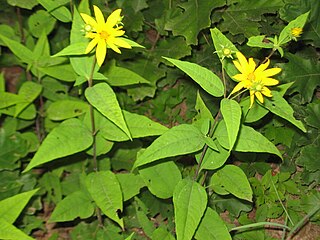
The common sunflower is a species of large annual forb of the daisy family Asteraceae. The common sunflower is harvested for its edible oily seeds which are used in the production of cooking oil.

The Jerusalem artichoke, also called sunroot, sunchoke, wild sunflower, topinambur, or earth apple, is a species of sunflower native to central North America. It is cultivated widely across the temperate zone for its tuber, which is used as a root vegetable.

Helianthus is a genus comprising about 70 species of annual and perennial flowering plants in the daisy family Asteraceae commonly known as sunflowers. Except for three South American species, the species of Helianthus are native to North America and Central America. The best-known species is the common sunflower. This and other species, notably Jerusalem artichoke, are cultivated in temperate regions and some tropical regions, as food crops for humans, cattle, and poultry, and as ornamental plants. The species H. annuus typically grows during the summer and into early fall, with the peak growth season being mid-summer.

Helianthus nuttallii, or Nuttall's sunflower, is a species of sunflower native to northern, central, and western North America, from Newfoundland west to British Columbia, south to Missouri, New Mexico, and California.

Helianthus giganteus, the giant sunflower or tall sunflower, is a species of Helianthus native to the eastern United States and eastern and central Canada, from Newfoundland west to Alberta south to Minnesota, Mississippi, and South Carolina.

Verbesina encelioides is a flowering plant in the family Asteraceae. The species is native to the Southwest United States and Northern Mexico. It is naturalized in parts of Eastern North America, the Middle East, Spain, Argentina, Australia and the Pacific islands. Common names include golden crownbeard, cowpen daisy, gold weed, wild sunflower, butter daisy, crown-beard, American dogweed, and the Spanish Añil del Muerto.

Helianthus californicus is a North American species of sunflower known by the common name California sunflower. It is native to California in the United States and Baja California in Mexico, where it grows in many types of habitats.

Helianthus ciliaris is a species of sunflower known by the common names Texas blueweed and yerba parda.

Helianthus maximiliani is a North American species of sunflower known by the common name Maximilian sunflower.

Helianthus divaricatus, commonly known as the rough sunflower, woodland sunflower, or rough woodland sunflower, is a North American species perennial herb in the family Asteraceae. It is native to central and eastern North America, from Ontario and Quebec in the north, south to Florida and Louisiana and west to Oklahoma and Iowa.

Helianthus grosseserratus, commonly known as sawtooth sunflower or thick-tooth sunflower, is a perennial sunflower in the family Asteraceae, with a large flowering head (inflorescence).

Chlosyne lacinia, the bordered patch or sunflower patch, is a North and South American butterfly in the family Nymphalidae.

Helianthus petiolaris is a North American plant species in the family Asteraceae, commonly known as the prairie sunflower or lesser sunflower. Naturalist and botanist Thomas Nuttall was the first to describe the prairie sunflower in 1821. The word petiolaris in Latin means, “having a petiole”. The species originated in Western United States, but has since expanded east. The prairie sunflower is sometimes considered a weed.

Helianthus debilis is a species of sunflower known by the common names cucumberleaf sunflower, beach sunflower, weak sunflower, and East Coast dune sunflower. It is native to the United States, where it can be found along the Atlantic and Gulf Coasts. It is known elsewhere as an introduced species, such as South Africa, Australia, Taiwan, Slovakia, and Cuba.

Helianthus angustifolius is a species of sunflower known by the common name narrowleaf sunflower or swamp sunflower. It is native to the south-central and eastern United States, found in all the coastal states from Texas to Long Island, and inland as far as Missouri. It is typically found in the coastal plain habitat, particularly in wet areas.

Helianthus decapetalus, known by the common names thinleaf sunflower and thin-leaved sunflower, is a perennial forb in the family Asteraceae. It is native to the Eastern and Central United States and Canada, from New Brunswick west to Iowa, Wisconsin, and Ontario, south as far as Georgia and Louisiana. It produces yellow composite flowers in late summer or early fall.

Helianthus eggertii, known as Eggert's sunflower, is a North American species of flowering plants in the family Asteraceae. It is native to Tennessee, Kentucky, South Carolina, and Alabama. It is best known as one of the few plants to have been delisted under the Endangered Species Act because of the species' recovery. It was described by John Kunkel Small in 1903.

Helianthus strumosus, the pale-leaf woodland sunflower, is a species of sunflower native to North America east of the Great Plains and is in the family Asteraceae. It is a native perennial sunflower that resembles other members of this family including the Pale Sunflower, Woodland Sunflower, Hispid Sunflower, and Jerusalem Artichoke. Pale-leaf sunflowers can be found in a diverse range of habitats including woodland areas, prairies, and meadows, providing that these habitats have access to partial sun.

Helianthus mollis is a species of sunflower known by the common names ashy sunflower, hairy sunflower or downy sunflower. It is widespread across much of the United States and Canada, primarily the Great Lakes region from Ontario south to Texas and Alabama. Additional populations are found in the states of the Atlantic Coast from Maine to Georgia, but these appear to be introduced.

Helianthus debilis subsp. cucumerifolius, or cucumberleaf dune sunflower, is a subspecies of the species Helianthus debilis in the genus Helianthus, family Asteraceae. It is native to the South Central regions of the United States and exists naturalized in every continent except Antarctica.



















